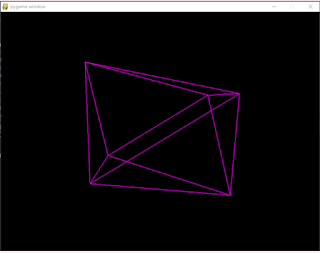Figuras en 3D de compañeros
*****Octaedro de Cynthia*****
Información de la figura en el blog de Cynthia
Código
Resultado:
**************figura 3D Cassandra*********** La siguiente figura la diseño mi compañera Casandra, la cual podemos encontrar en su blog
Código
Resultado:
********Diamante 3D por Alexis*********
La siguiente figura fue creada por mi compañero Alexis, la explicación esta en su blog
Código
Resultado:
*****Cubo en movimiento Hugo******
El siguiente cubo fue presentado por el compañero Hugo, el cual se mueve con las teclas de flechas, podemos verlo en su blog.
Resultado:
Código
import pygame
from pygame.locals import *
from OpenGL.GL import *
from OpenGL.GLU import *
verticies = (
(1, -1, 0),
(1, 1, 0),
(-1, 1, 0),
(-1, -1, 0),
(0, 0, 1.5),
(0, 0, -1.5),
)
edges = (
(5, 0),
(5, 1),
(5, 2),
(5, 3),
(4,0),
(4,1),
(4,2),
(4,3),
(0,1),
(0,3),
(2,1),
(2,3),
)
def Cube():
glBegin(GL_LINES)
for edge in edges:
for vertex in edge:
glVertex3fv(verticies[vertex])
glEnd()
def main():
pygame.init()
display = (800,600)
pygame.display.set_mode(display, DOUBLEBUF|OPENGL)
gluPerspective(45, (display[0]/display[1]), 0.1, 50.0)
glTranslatef(0.0,0.0, -5)
while True:
for event in pygame.event.get():
if event.type == pygame.QUIT:
pygame.quit()
quit()
glRotatef(1, 3, 1, 1)
glColor(128,0,128)
glClear(GL_COLOR_BUFFER_BIT|GL_DEPTH_BUFFER_BIT)
Cube()
pygame.display.flip()
pygame.time.wait(10)
main()
Resultado:
**************figura 3D Cassandra*********** La siguiente figura la diseño mi compañera Casandra, la cual podemos encontrar en su blog
Código
import pygame
from pygame.locals import *
from OpenGL.GL import *
from OpenGL.GLU import *
verticies = (
(0.2,0.4,0),
(0.4,0.2,0),
(0.4,-0.2,0),
(0.2,-0.4,0),
(-0.2,-0.4,0),
(-0.4,-0.2,0),
(-0.4,0.2,0),
(-0.2,0.4,0),
(0.2,0.4,1.5),
(0.4,0.2,1.5),
(0.4,-0.2,1.5),
(0.2,-0.4,1.5),
(-0.2,-0.4,1.5),
(-0.4,-0.2,1.5),
(-0.4,0.2,1.5),
(-0.2,0.4,1.5)
)
edges = (
(0,1),
(1,2),
(2,3),
(3,4),
(4,5),
(5,6),
(6,7),
(7,0),
(8,9),
(9,10),
(10,11),
(11,12),
(12,13),
(13,14),
(14,15),
(15,8),
(0,8),
(1,9),
(2,10),
(3,11),
(4,12),
(5,13),
(6,14),
(7,15)
)
def Cube():
glBegin(GL_LINES)
for edge in edges:
for vertex in edge:
glVertex3fv(verticies[vertex])
glEnd()
def main():
pygame.init()
display = (800,600)
pygame.display.set_mode(display, DOUBLEBUF|OPENGL)
gluPerspective(45, (display[0]/display[1]), 0.1, 50.0)
glTranslatef(0.0,0.0, -5)
while True:
for event in pygame.event.get():
if event.type == pygame.QUIT:
pygame.quit()
quit()
glRotatef(1, 3, 1, 1)
glClear(GL_COLOR_BUFFER_BIT|GL_DEPTH_BUFFER_BIT)
Cube()
pygame.display.flip()
pygame.time.wait(10)
main()
Resultado:
********Diamante 3D por Alexis*********
La siguiente figura fue creada por mi compañero Alexis, la explicación esta en su blog
Código
import pygame
from pygame.locals import *
from OpenGL.GL import *
from OpenGL.GLU import *
verticies = (
(-0.5,-0.87,1.5),#0
(0.5,-0.87,1.5),#1
(1,0,1.5),#2
(0.5,0.87,1.5),#3
(-0.5,0.87,1.5),#4
(-1,0,1.5),#5
(-1,-1.73,1),#6
(1,-1.73,1),#7
(2,0,1),#8
(1,1.73,1),#9
(-1,1.73,1),#10
(-2,0,1),#11
(0,0,-1.5),#12
)
edges = (
(0,1),
(1,2),
(2,3),
(3,4),
(4,5),
(5,0),
(6,7),
(7,8),
(8,9),
(9,10),
(10,11),
(11,6),
(12,6),
(12,7),
(12,8),
(12,9),
(12,10),
(12,11),
(0,6),
(1,7),
(2,8),
(3,9),
(4,10),
(5,11),
)
def Cube():
glBegin(GL_LINES)
for edge in edges:
for vertex in edge:
glVertex3fv(verticies[vertex])
glEnd()
def main():
pygame.init()
display = (1000,800)
pygame.display.set_mode(display, DOUBLEBUF|OPENGL)
gluPerspective(45, (display[0]/display[1]), 0.1, 50.0)
glTranslatef(0.0,0.0, -5)
while True:
for event in pygame.event.get():
if event.type == pygame.QUIT:
pygame.quit()
quit()
glRotatef(1, 3, 1, 1)
glClear(GL_COLOR_BUFFER_BIT|GL_DEPTH_BUFFER_BIT)
Cube()
pygame.display.flip()
pygame.time.wait(25)
main()
Resultado:
*****Cubo en movimiento Hugo******
El siguiente cubo fue presentado por el compañero Hugo, el cual se mueve con las teclas de flechas, podemos verlo en su blog.
import pygame
from pygame.locals import *
import random
from OpenGL.GL import *
from OpenGL.GLU import *
verticies = (
(1, -1, -1),
(1, 1, -1),
(-1, 1, -1),
(-1, -1, -1),
(1, -1, 1),
(1, 1, 1),
(-1, -1, 1),
(-1, 1, 1)
)
edges = (
(0, 1),
(0, 3),
(0, 4),
(2, 1),
(2, 3),
(2, 7),
(6, 3),
(6, 4),
(6, 7),
(5, 1),
(5, 4),
(5, 7)
)
surfaces = (
(0, 1, 2, 3),
(3, 2, 7, 6),
(6, 7, 5, 4),
(4, 5, 1, 0),
(1, 5, 7, 2),
(4, 0, 3, 6)
)
colors = (
(1, 0, 0),
(0, 1, 0),
(0, 0, 1),
(0, 1, 0),
(1, 1, 1),
(0, 1, 1),
(1, 0, 0),
(0, 1, 0),
(0, 0, 1),
(1, 0, 0),
(1, 1, 1),
(0, 1, 1),
)
def Cube():
glBegin(GL_QUADS)
for surface in surfaces:
x = 0
for vertex in surface:
x += 1
glColor3fv(colors[x])
glVertex3fv(verticies[vertex])
glEnd()
glBegin(GL_LINES)
for edge in edges:
for vertex in edge:
glVertex3fv(verticies[vertex])
glEnd()
def main():
pygame.init()
display = (800, 600)
pygame.display.set_mode(display, DOUBLEBUF | OPENGL)
gluPerspective(45, (display[0] / display[1]), 0.1, 50.0)
# start further back
glTranslatef(random.randrange(-5, 5), 0, -30)
object_passed = False
while not object_passed:
for event in pygame.event.get():
if event.type == pygame.QUIT:
pygame.quit()
quit()
if event.type == pygame.KEYDOWN:
if event.key == pygame.K_LEFT:
glTranslatef(-0.5, 0, 0)
if event.key == pygame.K_RIGHT:
glTranslatef(0.5, 0, 0)
if event.key == pygame.K_UP:
glTranslatef(0, 1, 0)
if event.key == pygame.K_DOWN:
glTranslatef(0, -1, 0)
'''
if event.type == pygame.MOUSEBUTTONDOWN:
if event.button == 4:
glTranslatef(0,0,1.0)
if event.button == 5:
glTranslatef(0,0,-1.0)
'''
x = glGetDoublev(GL_MODELVIEW_MATRIX)
camera_x = x[3][0]
camera_y = x[3][1]
camera_z = x[3][2]
glTranslatef(0, 0, 0.5)
glClear(GL_COLOR_BUFFER_BIT | GL_DEPTH_BUFFER_BIT)
Cube()
pygame.display.flip()
if camera_z <= 0:
object_passed = True
for x in range(10):
main()
Resultado:







Comentarios
Publicar un comentario